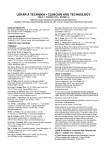Artefakty spôsobené pacientom pri zobrazovaní magnetickou rezonanciou
Authors:
Jozef Živčák 1; Marianna Trebuňová 2; Andrej Repovský 3; Galina Laputková 2
Authors‘ workplace:
Katedra biomedicínskeho inžinierstva a merania KBIaM, Strojnícka fakulta, TUKE, Košice, SR
1; Ústav lekárskej a klinickej biofyziky, Lekárska fakulta, UPJŠ, Košice, SR
2; Rádiologické oddelenie, Nemocnica A. Leňa, Humenné, SR
3
Published in:
Lékař a technika - Clinician and Technology No. 2, 2013, 43, 17-22
Category:
Original research
Overview
The main advantage of magnetic resonance imaging (MR) is the excellent tissue contrast, the possibility of the multiplanar imaging, non-invasiveness and not least the absence of the demonstrably harmful effect on the human body. Disadvantages consist in the fact that the examination of individuals with electronic implants and ferromagnetic vascular clamps is not possible, high purchase cost associated with high cost of screening, and limited availability of equipment in our country until recently [1]. In the present review the most important MR artifacts due to the patient are presented. The physical and technical aspects of the artifact origin and also the mechanism of its effect on the image signal is described.
Keywords:
artifacts, magnetic resonance, implants
Sources
[1] Černoch, Z. et al. Neuroradiologie. Hradec Králové: Nucleus HK, ISBN 80-901753-9-2, 2000, p. 573.
[2] Arena, L., Morehouse, H.T., Safir, J. MR imaging artifacts that simulate disease; How to recognize and to eliminate then. Radiographics, 1995, vol. 15, no. 6, p. 1373-1394.
[3] Heiland, S. Detect and avoid artifacts. Radiologie Up2Date, 2009, vol. 9, no. 4, p. 303-318.
[4] Delfaut, E.M. Fat suppression in MR imaging: techniques and pitfalls. Radiographics, 1999, vol. 19, no. 2, p. 373-382.
[5] Reimer P. et al. Clinical MR Imaging. A Practical Approach. 3rd Ed. Berlin: Springer, ISBN 978-3-540-74501-3, 2010, p. 831.
[6] Ehman, R. L., Felmlee, J. Flow artifact reduction in MRI: a review of the roles of gradient moment nulling and spatial presaturation. Magnetic Resonance in Medicine, 1990, vol. 14, no. 2, p. 293-307.
[7] Ordidge, R. et al. Correction of motional artifacts in diffusion-weighted MR images using navigator echoes. Magnetic Resonance Imaging, 1994, vol. 12, no. 3, p. 455-460.
[8] Pipe, J. G. Motion correction with PROPELLER MRI: application to head motion and free - breathing cardiac imaging. Magnetic Resonance in Medicine, 1999, vol. 42, no. 5, p. 963-969.
[9] Karger, C. P. et al. Accuracy of device-specific 2D and 3D image distortion correction algorithms for magnetic resonance imaging of the head provided by a manufacturer. Physics in Medicine and Biology, 2006, vol. 51, no. 2, p. 253-261.
[10] Chen, N.K., Wyrwicz, A.M. Optimized distortion correction technique for echo planar imaging. Magnetic Resonance in Medicine. 2001, vol. 45, no. 4, p. 525-528.
[11] Jezzard, P., Barnett, A.S., Pierpaoli, C. Characterization of and correction for eddy current artifacts in echo planar diffusion imaging. Magnetic Resonance in Medicine, 1998, vol. 39, no. 5, p. 801-812.
Labels
BiomedicineArticle was published in
The Clinician and Technology Journal

2013 Issue 2
Most read in this issue
- Artefakty spôsobené pacientom pri zobrazovaní magnetickou rezonanciou
- Hodnocení revaskularizace dolních končetin pomocí termografických měření a metodika
- Indikace k operační léčbě popálenin při využití metody laserdoppler imaging
- WEARABLE ARTIFICIAL KIDNEY – EVOLUTION OF ITS CONCEPTS AND CURRENT STATE-OF-THE-ART
